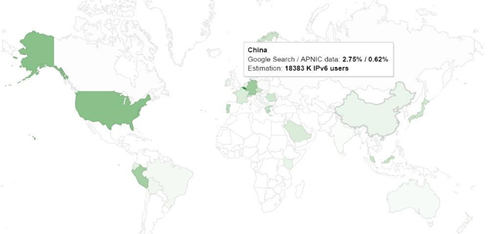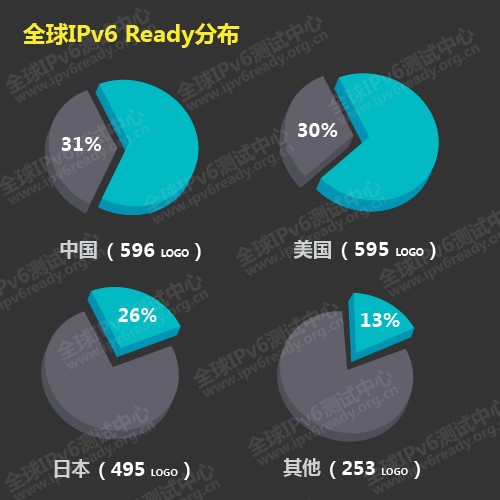Since Premier Li Keqiang proposed the plan for the Internet+ campaign in his delivery of the government work report at the beginning of this year, all sectors have actively and passionately been embracing internet, driven by which, Internet+ has been massively extending its catalysis in upgrading the conventional industries from the tertiary industry to all industry, and as it were, Internet+ is a hurricane that has swept across the world with the fortes of information technology seeded in all sectors and corners in social life and business development. As the Internet+ is booming, the number of the devices that need access to internet is bound to swell by severalfold or even dozens of times, tailed by the looming pest of lack of IP addresses. Against this background, IPv6-next generation internet, which is in pressing need of massive deployment, has become an important cornerstone that guarantees the internet development in the future.
With Hybrid of opportunities and challenges in Internet+, IPv6 is the key
At present, there are around 40% wired population in the world, and the figure is expected to reach 50% by 2017. Meanwhile, the campaigns of Internet+, Internet of Industry, etc. in many countries at full throttle will drive the explosion of the quantity of connected devices. It is estimated that at least 50 billion connected devices are expected by 2020, and then all the smart devices will need identification verification before they access the fixed networks and mobile networks, which poses a higher demand on smart performance, manageability, and security, and also on more IP addresses to accommodate the future network progressing on the fast track.
It is widely known that the internet with IPv6 at its core is bumping into festering technical and scale constraints. According to the ARIN sources lately, the maximum number of the remaining IPv4 addresses still available for allocation is only 2.1 million. The current IPv4 addresses in store will soon run out, brewed by which, the internet “gas-guzzlers”, such as the U.S. and China will bear the brunt of lack of IP addresses.
In order to navigate the barriers laid by the shortage of IP addresses in recent years, a new IP protocol called IPv6 has been brought to life, whose addresses, will reportedly be more than 340 trillion trillion trillion,accommodating each grain of sands on the earth with an address.
Mr. Vint Cerf, father of internet and the designer of TCP/IP, made an open call for large-scale penetration of IPv6, during his address at the Global IPv6 and Next Generation Internet Summit, that we evolve into IPv6 and phase out IPv4, and set our hands on the 21st century internet.
Led by the government and propelled by the industry, IPv6 on fast track in China
Owing to the belated introduction in China, the internet suffers handicapped development in IPv4, which is hard to change, and against this background, IPv6 is well received by China as the important infrastructure for deploying the next generation internet and promoting Internet+. As early as march 2012, National Development and Reform Commission (NDRC), in its Opinions on Next Generation Internet for Development of 12th five-year Plan, points out in an open manner that the target of over 25 million IPv6-connected broadband users must be hit during the 12th five-year plan. The Notice of Pilot City Projects on Next Generation Internet in Beijing and other 15 Cities and Metropolitan Areas jointly issued by MIIT and NDRC at the end of 2013 has been driving the application of IPv6 in China. In May 2015, MIIT and NDRC jointly released the Opinions on Full deployment and Application of IPv6 in LTE Networks. Propelled by a series of policies, China is racing fast in the commercial deployment of IPv6 networks, and the IPv6 users in China have outnumbered those in Germany (10 million) and Japan (7.5 million), to enable China to become the runner-up second only to the United States.

IPv6 Population over 18 million in China
On top of this, the batch of policies have apparently blasted off the development in China’s IPv6 market, where various major vendors actively deploy IPv6, and make IPv6 compatibility as one of the indexes for marketing. In 2008, the Global IPv6 Test Center (G6TC) (www.ipv6ready.org.cn) became one of three IPv6 testing centers around the world. According to the 2014 Global IPv6 Ready Support Report issued by BII-G6TC, the overall compatibility with IPv6 and the number of IPv6 compatible devices will see an enormous bump-up. By December 31st 2014, 1939 IPv6 Ready Logos have been released globally, among which, China has 596, accounting for 31% of the total quantity, second to none in the world, with which, China has been the bellwether in the world for two consecutive years.

Global Distribution of IPv6 Ready
The era of Internet+ is on our doorstep, when people-to-people and thing-to-thing information exchanges and sharing, and the exchanges and sharing between people and things stress further the infrastructure resources and technologies. Oceans of address space, fast computing, mobilization of cloud, and other application demands drive the development of technical resources in China. With the potential address availability, its support of mobility, guarantee of service, security and other flexibilities, IPv6 is not only a solution to tackling the shortage of IPv4 addresses, but an important fulcrum for the complex, free-changing, and auto-operating future networks, and a thruster for Internet+.
| Copy Right Owner of the Webpage: BII GROUP | 京ICP备09059086号-5 |
